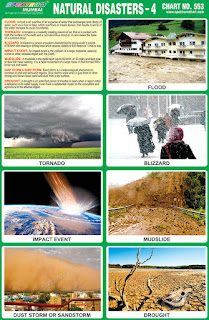 |
| Natural Disasters 4 Chart |
Spectrum Chart - 553 : Natural Disasters - 4
1. Flood - A flood is an overflow of water
on land which is usually dry. Sometimes a river receives too much
extra water, either from heavy rain or other natural disasters. When
this happens, the water overflows from its normal path in the river
bed and onto dry land. This is called a flood. Extreme flooding can
also be caused by a tsunami or a large storm that will cause the sea
to surge inland. Floods often cause damage to homes and businesses if
they are in the natural flood plains of rivers.
2. Tornado - A tornado is a violently
rotating column of air that is in contact with both the surface of
the earth and a cumulonimbus cloud. They are often referred to as
twisters. The most extreme tornadoes can attain wind speeds of more
than 480 km/h. Tornadoes have been observed on every continent except
Antarctica. An EF0 (Enhanced Fujita Scale) tornado will probably
damage trees but not substantial structures, whereas an EF5 tornado
can rip buildings off their foundations leaving them bare and even
deform large skyscrapers.
3. Blizzard – A blizzard is a severe
snowstorm characterised by strong sustained winds of at least 35 mph
and lasting for a prolonged period of time—typically three hours or
more. A ground blizzard is a weather condition where snow is not
falling but loose snow on the ground is lifted and blown by strong
winds. Blizzards can bring whiteout conditions, and can paralyse
regions for days at a time, particularly where snowfall is unusual or
rare.
4. Impact Event – An impact event is a
collision between objects in space. They happen regularly in
planetary systems, such as our Solar System. They most often involve
small objects, such as asteroids, comets or meteors. These have
relatively little impact. When a large object collides with a planet
like the Earth, it can have serious effects on the planet. Depending
on the size of the object, much of the impact is reduced by the
planet's atmosphere. Smaller objects explode or break apart as they
enter the atmosphere. Hundreds of impacts have been reported on
Earth.
5. Mudslide – A mud flow or mudslide
occurs when mud travels down a slope very quickly. Mudslides, which
are like giant moving mud pies, happen when lots of water mixes with
soil and rock. The water makes the slippery mass of mud flow quickly
down. Mudslides happen most in mountainous places where a long dry
season is followed by heavy rains.
6. Dust Storm or Sandstorm – A dust
storm or sandstorm, is a storm of small particles of sand and dirt.
Dust storms happen when a strong wind front blows loose sand and dust
from a dry surface. Particles are picked up and suspended in the air,
causing soil erosion where they were. The wind drops them in another
place where they can form silt. Dust storms cause soil loss from the
dry lands, they preferentially remove organic matter and the
nutrient-rich lightest particles, thereby reducing agricultural
productivity.
7. Drought - A drought is a period of
below-average precipitation in a given region, resulting in prolonged
shortages in its water supply, whether atmospheric, surface water or
ground water. A drought can last for months or years. It can have a
substantial impact on the ecosystem and agriculture of the affected
region.

No comments:
Post a Comment